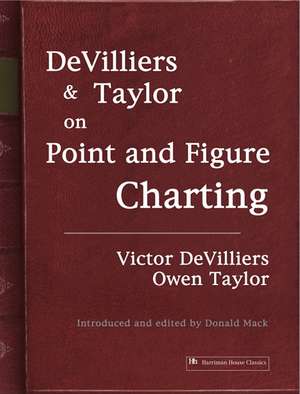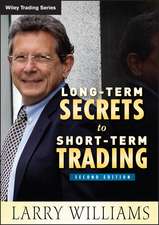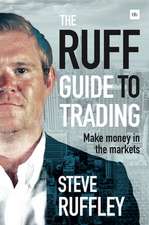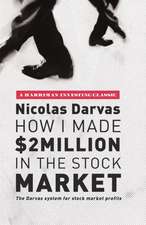Devilliers and Taylor on Point and Figure Charting
Autor Victor Devilliers, Owen Tayloren Limba Engleză Paperback – 6 apr 2007
Preț: 238.06 lei
Preț vechi: 274.81 lei
-13% Nou
Puncte Express: 357
Preț estimativ în valută:
45.55€ • 47.78$ • 37.92£
45.55€ • 47.78$ • 37.92£
Carte disponibilă
Livrare economică 11-25 martie
Preluare comenzi: 021 569.72.76
Specificații
ISBN-13: 9781905641529
ISBN-10: 1905641524
Pagini: 308
Dimensiuni: 210 x 297 x 18 mm
Greutate: 0.75 kg
Editura: HARRIMAN HOUSE LTD
ISBN-10: 1905641524
Pagini: 308
Dimensiuni: 210 x 297 x 18 mm
Greutate: 0.75 kg
Editura: HARRIMAN HOUSE LTD
Cuprins
Preface to First Edition Introduction to First Edition 1 THE PRINCIPLES OF THE POINT AND FIGURE METHOD Logic is the basis of this Method Irrelevant fluctuations eliminated How the Method got its name Graphs are logical and scientific Introductory summary of important principles Needed accessories are few Plotting a stock price movement One point charts the basis of the Method Accessories and working tools 2 THE WEIGHT OF AUTHORITY BEHIND THIS METHOD Refined to coordinate with present day markets Mystery and complications have been clarified Expensive financial and economic reports unnecessary Certain factors taken for granted Analytical technique easy to master Losses limited while profits accrue Method weighs forces of buying and selling 3 ADVANTAGES OF THIS METHOD OVER OTHERS Speed and ease of recording data The Method ignores volume Price changes versus volume Supply versus demand Volume easily manipulated Facility of this method The utter simplicity of the records Manipulation readily detected Use all full figure changes in making charts Method is superior to inside information Isolation develops best results Our charts reveal plans of the majority How the move begins Stock market trading is a business Inside information unnecessary One point charts show all 4 THE VITAL POINTS Vital point I - recording full figure changes Vital point Il - only full figure changes Vital point III - suitable graph paper Vital point IV - use of horizontal and vertical columns Vital point V - trend reversals Vital point VI - only one symbol to a square Vital point VII - move over diagonally Vital point VIII - skip no squares Vital point IX - formation of congestion area Vital point X - the full fulcrum Vital point XI - first buying point Vital point XII - the catapult Vital point XIII - secondary buying point Vital point XIV - the semi-catapult Vital point XV - third buying point Vital point XVI - watch for distribution Vital point XVII - trend lines Vital point XVIII - forecasting the extent of the move 5 APPROVED METHOD OF ASSEMBLING AND MAINTAINING PROPER DATA The ticker tape Source of all data Daily full figure fluctuations available Method ideal for those at distant points Application of the data How to prepare and collate the needed data Proper graph paper helpful Arrange charts orderly How to select the issues to record Clarifying the use of the symbols Moving to next vertical column Use of symbol "O?? One cardinal principle Gaps are not recorded How the gap occurs Plotting the gap The one point chart The three point and five point charts Condensing the one point moves Other helpful aids The method substitutes for tape reading Trend outline and geometrical charts The proper issues to chart Commodity price movements 6 THE SCIENTIFIC FUNDAMENTALS The fulcrum Leverage Watch for a fulcrum The ideal full fulcrum Down trend a prerequisite to fulcrum formation Supply equals demand Advantage of figure charts The buying points The broad fulcrum The recoil fulcrum The catapult The true catapult The false catapult The semi catapult Use "stops" to protect position 7 THE PRINCIPLES OF CHARTING The one point chart Move to next column signs of a fulcrum Technical aids The three point chart Determining three point moves The use of five point charts 8 ANALYZING TECHNICAL POSITION The price path characteristics Patterns of the leaders duplicated in the secondary issues Solid formations give confidence Watch for changes in activity Strong and weak technical position Weak technical position Gauging the length and culmination of the moves The count Coordinating your studies 9 ANTICIPATING THE ACTION OF U.S. STEEL The full ideal fulcrum The catapult position The semi-catapult position Consolidating the gains The final mark up The end of the move - a reverse fulcrum The short positions Geometrical charts The trend outline charts The three point figure charts The five point charts Summary 10 ANALYZING A CAMPAIGN IN WESTERN UNION Selecting the fast moving issues The full fulcrum base The catapult The semi-catapults The short positions Summary 11 JUDGING THE MINOR SWINGS The half hourly index of the Dow Jones Industrials The half point half hourly log Half point technique Scientific tape reading Analyzing the half point chart Ignore rumors and gossip Summary 12 HALF POINT TECHNIQUE IN ATLAS TACK Historical background Analyzing the campaign in Atlas Tack Important signal during July break The first caution signal Board room observations The shorts began to cover Point and Figure analysis 13 THE MAIN TREND AND MAJOR CYCLE CULMINATIONS Critical culmination points easily detected The one point chart - the basis for analysis Interpreting an intricate major culmination The first temporary top Semi-catapult point - unusually bullish pattern Strength carries through objective level The change over of technical action The top of the move clearly indicated Indications of a major culmination Bear trend technical action The investor or long term trader 14 TECHNICAL INDICATIONS AT A TURNING POINT The change to an up trend The change to a down trend Conclusion VOLUME 2 ADVANCED THEORY AND PRACTICE OF THE POINT AND FIGURE METHOD 1 PREREQUISITES TO SUCCESSFUL TRADING Develop proper mental approach The value of isolation Proper and adequate physical equipment Technical knowledge and equipment The Importance of selective data Tape watching or active trading 2 BASIC PRINCIPLES - THEIR APPLICATION Basic principles underlying this method The trading range - accumulation The fulcrum The mark up Distribution The trend line For long term main trend operations Plotting the trend line Technical position Determining the technical position of the market position through the use of the five dominant positions Resume 3 CHART FORMATIONS INDICATED THE INCEPTION OF A MOVE The value of charts One cardinal principal which must be understood A necessary premise Wait for signs of accumulation or distribution What to look for Await previous support How the move begins Establishing a long position A practical example Dead center The use of the stop Ultra-conservitism 4 RECURRING OPPORTUNITIES DURING THE MOVE Study creates skill Recognizing opportunities Dividend absorbed A long position established "on stop?? Judging the move Confirmation of the move A critical analysis of trading zones How to plot new trend lines 5 THE ONE POINT CATAPULT AND SEMI-CATAPULT Strong signals Illustrations of catapult and semi-catapult patterns Broad fulcrum desirable Catapult and semi-catapult not the same as the conventional "new high?? Tracing a move in DuPont The ladle formation Confirmation How to analyze the trend Watch the trend line and use stops 6 GAUGING THE VOLATILE ISSUES A fast mover An unusual and unique device Individual characteristics often repeated Long positions Consolidation zone Three point summaries should be consulted 7 HOW TO RECOGNIZE ADDITIONAL OPPORTUNITIES INVOLATILE STOCKS Low priced stockS Avoid guesswork Erratic stocks not dangerous Consider the unexpected Conservation pays The importance of dividends, extras, and rights Watch "ex-dividend" dates Limit losses let profits accrue Continually analyze the formations 8 CULMINATION, LIQUIDATION, PROFIT TAKING, AND THE SHORT SIDE When to take your profits One point signals on the short side The reaction pattern in ACF Signal for the short side Watch for signs of absorption The inverse catapult Signals for short and long positions Analyzing a stock for technical position Signs of culmination 9 THE THREE POINT CHART How to prepare the three point chart Averages a confirmation Watch for the balance of forces The importance of seasonal trend Three point analysis 10 COORDINATING THE ONE POINT WITH THE THREE POINT CHARTS Three point chart a check on the one point chart Illustrations of coordination Inside accumulation Manipulator's campaign The manipulator's methods The false start Pool switches to short side 11 THE COUNT - GAUGING THE EXTENT OF FUTURE MOVES The theory underlying the count The count not an exact science Horizontal formation may disclose the extent of the move The principle of "the count" The one point count The forecast Anticipating the next move Additional charts for study The count by three points A new point for a forecast Accuracy of the count A three point test for future market action Cumulative implications more reliable
Notă biografică
Victor DeVilliers andOwen Taylor














